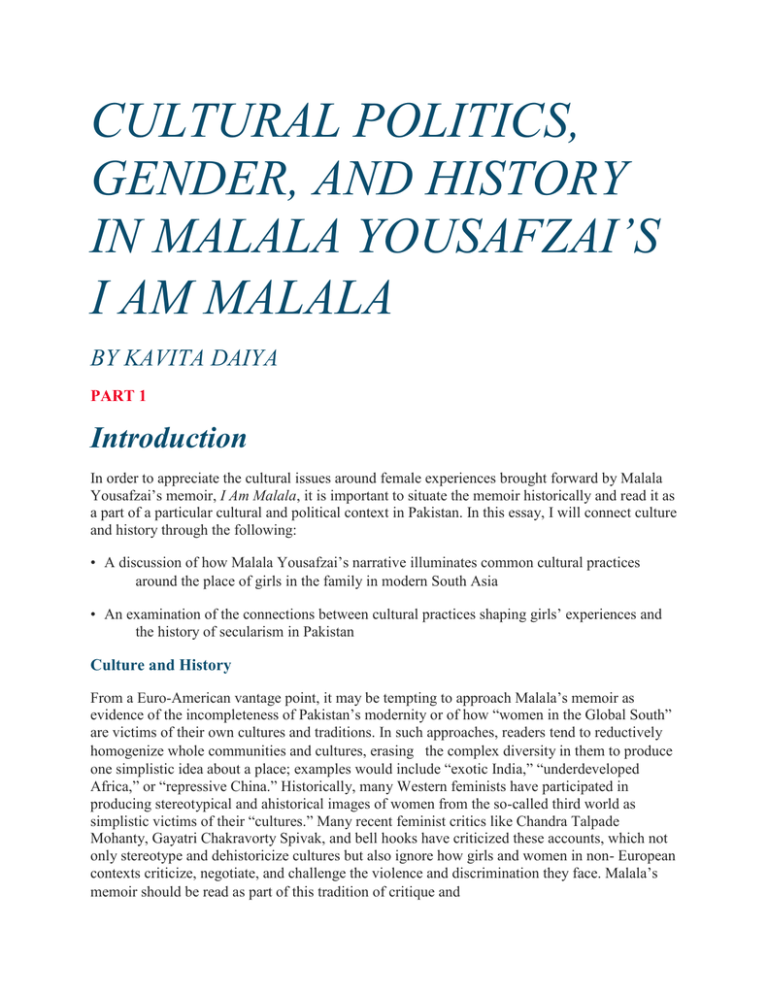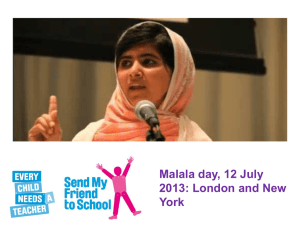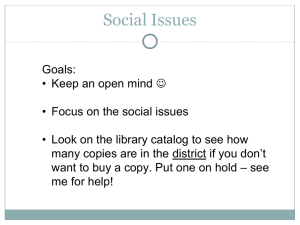CULTURAL POLITICS, GENDER, AND HISTORY IN MALALA
advertisement

CULTURAL POLITICS, GENDER, AND HISTORY IN MALALA YOUSAFZAI’S I AM MALALA BY KAVITA DAIYA PART 1 Introduction In order to appreciate the cultural issues around female experiences brought forward by Malala Yousafzai’s memoir, I Am Malala, it is important to situate the memoir historically and read it as a part of a particular cultural and political context in Pakistan. In this essay, I will connect culture and history through the following: • A discussion of how Malala Yousafzai’s narrative illuminates common cultural practices around the place of girls in the family in modern South Asia • An examination of the connections between cultural practices shaping girls’ experiences and the history of secularism in Pakistan Culture and History From a Euro-American vantage point, it may be tempting to approach Malala’s memoir as evidence of the incompleteness of Pakistan’s modernity or of how “women in the Global South” are victims of their own cultures and traditions. In such approaches, readers tend to reductively homogenize whole communities and cultures, erasing the complex diversity in them to produce one simplistic idea about a place; examples would include “exotic India,” “underdeveloped Africa,” or “repressive China.” Historically, many Western feminists have participated in producing stereotypical and ahistorical images of women from the so-called third world as simplistic victims of their “cultures.” Many recent feminist critics like Chandra Talpade Mohanty, Gayatri Chakravorty Spivak, and bell hooks have criticized these accounts, which not only stereotype and dehistoricize cultures but also ignore how girls and women in non- European contexts criticize, negotiate, and challenge the violence and discrimination they face. Malala’s memoir should be read as part of this tradition of critique and dissent if we do not want to reduce her to this stereotype of third world woman/victim. As Malala also insists, “I don’t want to be thought of as the ‘girl who was shot by the Taliban’ but the ‘girl who fought for education. ’ ” (152-153) If we want to understand Malala, as she herself wishes, as an active, resistant, and political actor in her Pakistani and Muslim community, then we have to attend to the history of Pakistan and secularism, which profoundly shapes her as a political subject. Pakistan is a relatively young nation: It was formed in August 1947 when the British decolonized the Indian subcontinent. At the same time that the British granted India independence, they also divided it and created two countries, Pakistan and India. Having stoked fears on the part of Muslims that they would be oppressed in a free India, as they were outnumbered by Hindus, the British enacted a partition along religious lines. Many Muslim-majority regions formed “Pakistan,” and Hindumajority areas were named “India.” Pakistan became independent on Aug. 14, 1947, and India on Aug. 15, 1947. Thus, from the start, the popular understanding was that Pakistan was created “for Muslims,” so that they would not be a minority in what was a Hindu-majority India. Following this partition, approximately 7 million Muslims migrated from India to Pakistan; called mohajirs, or migrants, they faced discrimination as outsiders. As a result, they eventually mobilized themselves and became a political force: the Muttahida Quami Movement (MQM). Malala also refers to the mohajirs and their political clout: “The MQM is a very organised movement and the mohajir community sticks together.” (111) In part, the large scale of Partition migrations was a consequence of religious violence; when the locations of the borders were announced by radio on Aug. 16, Hindus and Sikhs attacked Muslims and vice versa. Approximately 2 million people died in the span of one year, while by official counts, 5 million Hindus and Sikhs left Pakistan for India, and 7 million Muslims left India for Pakistan. In this, as in other moments of ethnic conflict, women became targets of terrible sexual violence, mutilation, abduction, and commodification. The experience and enduring impact of this gendered ethnic violence have been the focus of much research, including my first book, Violent Belongings: Partition, Gender and National Culture in Postcolonial India ([2008] 2013). Subsequently, as feminist historians Ritu Menon and Kamala Bhasin detail, from 1948 till 1956, both India and Pakistan agreed to forcibly repatriate and “exchange” the over 100,000 women who had been abducted, regardless of the women’s own wishes. They were also forced to leave behind any children they had after their abduction. Enacted at the scale of the nation-state, this dehumanizing action formally cast women as property that “belonged” to both the ethnic community they were born in and the nation. This idea that women are not equal citizens but rather that they “belong” to the nation and community—also operative in other conflict zones from Bosnia to Rwanda—has continued to shape women’s experiences during conflict. Secularism and Gender Mohammed Ali Jinnah, founder of Pakistan, had originally intended for Pakistan to be a Muslim country but a constitutionally secular state in which all communities— Hindu, Christian, Parsi, Sikh, Muslim—lived peacefully, and women and men had equal rights (21, 49). However, he passed away shortly after independence, and since then, the Pakistani government has had a checkered relationship with institutions of secularism. In Chapter 20, Malala refers to this history when she describes her trip to Jinnah’s tomb in Karachi. She asserts how Jinnah had dreamed of a secular and inclusive Pakistan when he had founded the country. After 1947, ethnic minorities including many Hindus, Parsis, Jews, and Sikhs left the country, fleeing religious persecution. After Jinnah, successive political leaders colluded with the Army and religious groups as they jockeyed for political power. As political power shifted back and forth from democratic forces to the military in different decades, the period from 1977 to 1988 under the military dictator Zia ul Haq saw a mass movement sweeping the countryside and the cities of Pakistan that argued for the radical Islamization of both state and civil society. While religious parties were able to consolidate popular support from a largely uneducated and unemployed youth, as there was little industry in the fledgling nation to support the growth of a middle class, the Harvard- and Oxford- educated political elite often made compromises with the Army and the religious parties to preserve their power. Malala observes in her memoir that General Zia argued that the Army’s government was “pursuing Islamic principles” and opened many religious schools across the country. He ushered in much repression, from setting up “prayer committees in every district” and “prayer inspectors” to changing laws so that a woman’s word in court counted for “only half that of a man’s.” (21) The film Khamosh Pani (Silent Waters, 2003) by notable Pakistani independent filmmaker Sabiha Sumar captures this transformation poignantly, tracing how it affects the life of a female Partition survivor in rural Pakistan. The film depicts the experience of rape and sexual violence that women experienced during the 1947 Partition, and connects it with how women again became increasingly erased from public life and stripped of equal rights with General Zia’s 1979 Islamization of Pakistan. Khamosh Pani won critical acclaim at film festivals globally. Alongside this, any understanding of Pakistan must consider how it was and continues to be affected by the political history of its neighbor Afghanistan; indeed, the rise to power of the Taliban in the Khyber-Pakhtunkhwa region, formerly known as North West Frontier Province, where Malala is from, is not unrelated to the rise of the Taliban in Afghanistan during the Cold War. From 1979 to 1988, the United States covertly funded, trained, and armed mujahideen militants through Pakistan, creating what became the Taliban to resist the Russian occupation of Afghanistan. Malala is keenly aware of and criticizes both Zia’s Islamization and the American involvement in Cold War Taliban politics and support of Pakistan’s military rulers. As Malala also mentions, in 1979, once Russia invaded Afghanistan and the U.S.-supported shah of Iran was overthrown, the U.S. lost its regional base in Iran and so shifted to Pakistan: “Billions of dollars flowed into our exchequer from the United States ... and weapons to help the ISI [Pakistan Inter-Services Intelligence Agency] train the Afghans to fight the [Russian] communist Red Army. General Zia was invited to meet President Ronald Reagan at the White House ... The US government lavished praise on him.” (22) Girls and Male Privilege If we approach culture as a historically changing set of learned and shared ideas and practices, then we can understand better how the cultural privileging of boys manifests itself in different ways across the world. Malala’s memoir shows how poor families in Pakistan and many other parts of South Asia endeavor to ensure that the boys get some kind of education and often care less if their daughter remains illiterate, because she does not need to be educated to assume the expected role of wife and mother. In an early moment in her narrative, describing the birth of her younger brother, Malala recalls, “My mother had been waiting for a son and could not hide her joy when he was born. To me he seemed very thin and small, like a reed that could snap in the wind, but he was the apple of her eye, her ladla. It seemed to me that his every wish was her command.” (16) This moment where Malala recognizes the inequality between her and her brother’s treatment signals how, from the moment they are born, male children are prized and privileged over female children in a large majority of families in South Asia. This has terrible implications for girl children. The powerful documentary It’s a Girl (2012) shows that female infanticide has generated a massive gap in the population ratio of men to women across a large part of Asia, where, according to the United Nations, an estimated 200 million women are missing due to gendercide. The social organization of South Asia’s many communities is largely patriarchal. Many believe that the son will eventually care for the parents when they are old, providing a safety net for the future in a society without any state-sponsored social security. The son therefore is to be prized; the daughter, however, will marry and leave for her husband’s family. She is thus often seen as an economic burden, even as she performs unrecognized but valuable labor in the fields and the home for her family. These patriarchal ideas that the son is superior to the daughter prevail in middle-class and wealthy families as well. It is not uncommon therefore to see, as Malala describes, the husband and son in the family getting the choice meats at dinnertime, or more food, more milk or eggs, which is expensive, while the daughter-in- law or daughter gets less or none (21-22). This kind of discrimination is both subtle and deeply unfair, as it inhabits the intimate relations of a family and indelibly will shape the sense of self-worth as well as physical health of the girls and women in the family. Malala is able to cast a critical lens on this, because her father, Ziauddin Yousafzai, who is educated, liberated, and fair-minded, rejects this gender- based way of treating girls as less, and she embraces his perspective. Because of his education and support, she is able to challenge gender inequality within her culture. But many others are not so fortunate. In 2009, I investigated the tragic and untimely death of my 34-year-old cousin Kavita, married into a very rich family in Mumbai, India. I learned that in the four years of her marriage, she had been tortured and abused in various ways, including the deprivation of food. Sometimes the house servant would sneak a sandwich into her room out of pity; sometimes she got food through her sister. This family hid bars of gold in their wardrobes and bank lockers, and yet withheld nutritious food from my cousin. This is not an isolated story: Most girls learn early that they can expect to get less food than boys. Cultural Politics and Women’s Struggles “We talked about how things happen for different reasons, this happened to me, and how education for females not just males is one of our Islamic rights. I was speaking up for my right as a Muslim woman to be able to go to school.” (141) This is a poignant moment, underscoring how at the heart of Malala’s story is a vulnerable girl child wanting only to go to school to learn things about her own life and the world. It is also a powerful moment in which Malala is showing us a complex vision of Pakistani culture: one that allows debate and dissent on what actually IS Pakistani and Islamic culture. That secularism is a problematic and contested idea in Pakistan is apparent even in Malala’s text. She discovers that the Taliban have named her as a target only when she happens to meet the Pakistani-American journalist Shehla Anjum on a visit to Karachi, and Anjum mentions this to her: “We didn’t know what she was talking about so she went on the Internet and showed us that the Taliban had that day issued threats against two women—Shad Begum, an activist in Dir, and me, Malala. ‘These two are spreading secularism and should be killed,’ it said.” (112) In response to the Taliban’s claim that education is un-Islamic and “Western,” Malala asserts: “Today we all know education is our basic right. Not just in the West; Islam too has given us this right. Islam says every girl and every boy should go to school. In the Quran it is written, God wants us to have knowledge. ” (263) Similarly, later in the narrative, she argues, “I love my God. I thank my Allah. I talk to him all day. He is the greatest. By giving me this height to reach people, he has also given me great responsibilities. Peace in every home, every street, every village, every country—this is my dream. Education for every boy and every girl in the world. To sit down on a chair and read my books with all my friends at school is my right.” (265) The Taliban’s view of culture, and of women’s role as silent property, is thus being challenged by Malala, civil society, and now the government. Toward the end of her memoir, Malala notes how many girls’ schools and colleges in Pakistani cities had been attacked and bombed since she left for England. It is very clear that even when segregated in all-girls schools and colleges, where thousands of Pakistani parents are sending their girls to get an education that they hope might lead them to a better life, female education is not acceptable to the Taliban. What is at stake then is both the autonomy and rights of local Pakistanis, as well as the very place and personhood of the girl child—within the family and home, and outside in public life and in the institutions of civil society, like schools.



